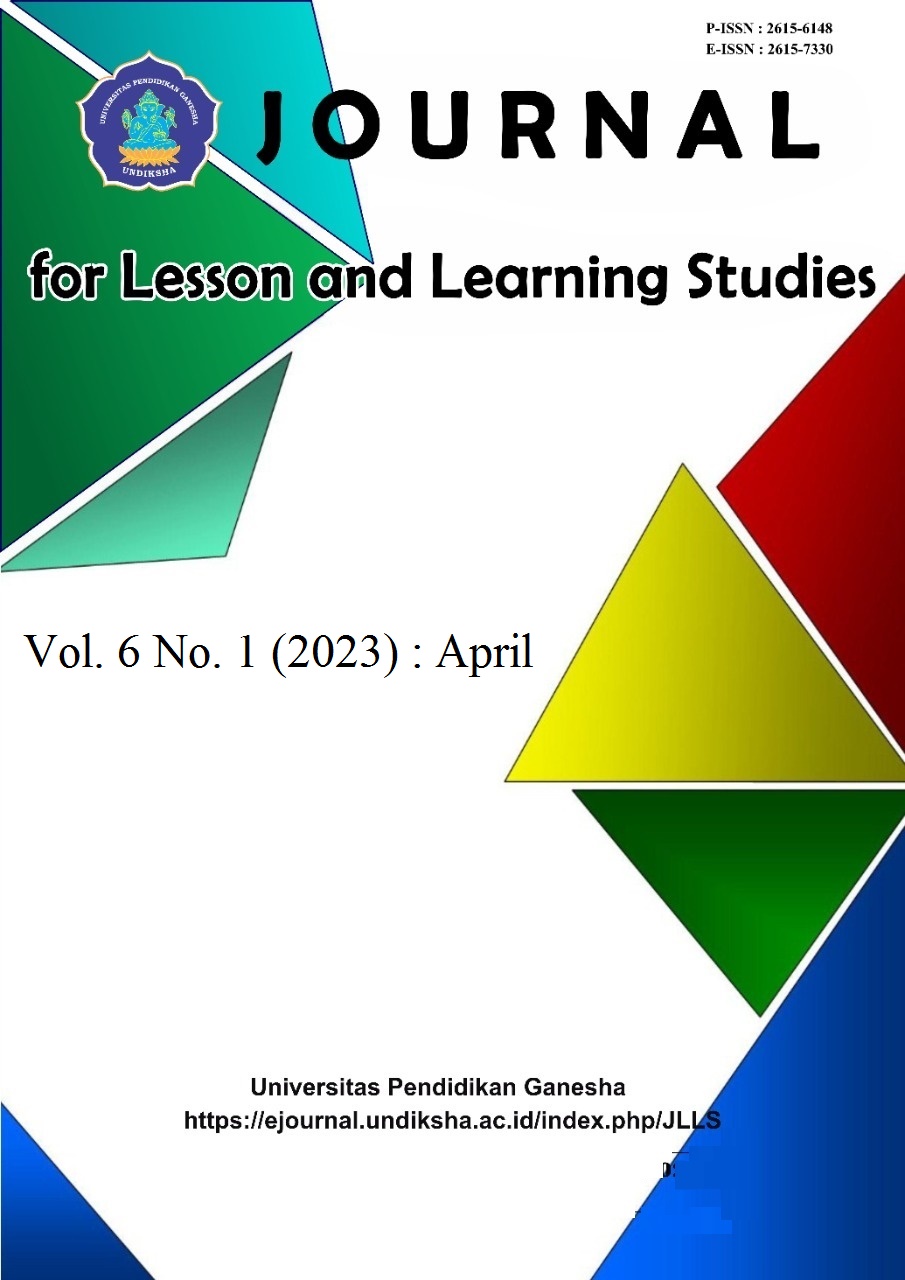Physics Learning Using Guided Inquiry Models Based on Virtual Laboratories and Real Laboratories to Improve Learning
DOI:
https://doi.org/10.23887/jlls.v6i1.61000Kata Kunci:
Inkuiri Terbibing, Laboratorium Virtual, Laboratorium Real, Hasil BelajarAbstrak
Telah dilakukan penelitian pengaruh model pembelajaran inkuiri terbimbing berbasis eksperimen virtual dan real terhadap hasil belajar fisika siswa. Tujuan dari penelitian ini adalah mengetahui seberapa besar pengaruh metode eksperimen yang dipadukan dengan model pembelajaran inkuiri terbimbing berbasis eksperimen virtual dan real erhadap hasil belajar fisika siswa kelas XI di XI IPA SMA Methodist-1 Medan. Sampel penelitian ini ialah kelas XI IPA 1 (32 orang) untuk kelompok eksperimen dan kelas XI IPA 2 (32 orang) untuk kelompok kontrol. Pada penelitian ini memanfaatkan teknik sampling cluster random sampling. Teknik pengumpulan data dalam penelitian berupa instrumen tes hasil belajar pada awal (pretes) dan pada akhir pembelajaran (post-test). Teknik analisis data yang digunakan adalah uji normalitas dan uji independent sample t-test. Untuk pengujian hipotesis penelitian digunakan uji kesamaan dua rata-rata menggunakan uji t, yaitu independent sample t-test atau uji analisis varians 1 arah (anova) dengan menggunakan program SPSS versi 21 pada taraf signifikansi α = 0,05. Berdasarkan hasil analisis uji t maupun anova diperoleh nilai Sig (2-tailed) sebesar 0,000 yang berarti lebih kecil dari nilai taraf signifikan 0,05 maka dapat disimpulkan bahwa model pembelajaran inkuiri terbimbing menggunakan laboratorium virtual dan laboratorium real untuk berpengaruh terhadap hasil belajar fisika siswa (0.000 < 0.05). Berdasarkan hasil-hasil penelitian, maka dapat disimpulkan bahwa pembelajaran fisika menggunakan model pembelajaran inkuiri terbimbing berbasis eksperimen virtual dan real menggunakan dapat meningkatkan hasil belajar fisika siswa, yang dibuktikan dari perbedaan perolehan nilai rata-rata hasil belajar siswa pada kelas ekperimen lebih tinggi (87.47) dibandingkan dengan kelas kontrol (69.72).
Referensi
Abdjul, T. da. N., & E, N. (2019). Penerapan Media Pembelajaran Virtual Laboratory Berbasis Phet terhadap Hasil Belajar Siswa pada Materi Gelombang. Jurnal Pendidikan Fisika Tadulako Online (JPFT, 7(3), 26–31. http://jurnal.untad.ac.id/jurnal/index.php/EPFT/article/view/14383.
Adlina, S., Manurung, S. R., & Apriani, Y. (2019). Efektivitas model discovery learning berbantuan simulasi phet terhadap hasil belajar fsika di kelas X sma swasta alwashliyah 1 medan. Jurnal Inovasi Pembelajaran Fisika (INPAFI, 7(4), 9–16. https://doi.org/10.24114/inpafi.v7i4.17070.
Afandi, Sajidan, Akhyar, M., & Suryani, N. (2019). Development Frameworks of the Indonesian Partnership 21st-Century Skills Standards for Prospective Science Teachers: A Delphi Study. Jurnal Pendidikan IPA Indonesia, 8(1), 89–100. https://doi.org/10.15294/jpii.v8i1.11647. DOI: https://doi.org/10.15294/jpii.v8i1.11647
Amijaya, L. S., Ramdani, A., & Merta, I. W. (2018). Pengaruh model pembelajaran inkuiri terbimbing terhadap hasil belajar dan kemampuan berpikir kritis peserta didik. JPM: Jurnal Pijar MIPA, 13(2), 94–99. https://doi.org/10.29303/jpm.v13i2.468. DOI: https://doi.org/10.29303/jpm.v13i2.468
Anindayati, A. T., & Wahyudi, W. (2020). Kajian Pendekatan Pembelajaran Stem Dengan Model Pjbl Dalam Mengasah Kemampuan Berpikir Kreatif Matematis Siswa. EKSAKTA : Jurnal Penelitian Dan Pembelajaran MIPA, 5(2), 217. https://doi.org/10.31604/eksakta.v5i2.217-225. DOI: https://doi.org/10.31604/eksakta.v5i2.217-225
Ekawati, Y., Haris, A., & Amin, B. (2015). Penerapan Media Simulasi Menggunakan PHET Physics Education And Technology) Terhadap Hasil Belajar Fisika Peserta Didik Kelas X SMA Muhammadiyah Limbung. Jurnal Pendidikan Fisika Unismuh, 3(1), 74–82. https://doi.org/10.26618/jpf.v3i1.254.
Hanik, N. R., Harsono, S., & Nugroho, A. A. (2018). Penerapan Pendekatan Contextual Teaching and Learning dengan Metode Observasi untuk Meningkatkan Hasil Belajar pada Matakuliah Ekologi Dasar. Jurnal Pendidikan Matematika Dan IPA, 9(2), 127–138. https://doi.org/10.26418/jpmipa.v9i2.26772. DOI: https://doi.org/10.26418/jpmipa.v9i2.26772
Huertas-Abril, C. A. (2021). Developing speaking with 21st Century digital tools in the English as a foreign language classroom: New literacies and oral skills in primary education. Aula Abierta, 50(2), 625–634. https://doi.org/10.17811/RIFIE.50.2.2021.625-634. DOI: https://doi.org/10.17811/rifie.50.2.2021.625-634
Karlina, N., Sahara, & Sukariasih, L. (2019). Penerapan Model Pembelajaran Inkuiri Terbimbing untuk Meningkatkan Aktivitas dan Hasil Belajar IPA Fisika Siswa SMP. Jurnal Penelitian Pendidikan Fisika, 4(1), 8–16. https://doi.org/10.36709/jipfi.v4i1.14138. DOI: https://doi.org/10.36709/jipfi.v4i1.14138
Labouta, H. I., Kenny, N. A., Li, R., Anikovskiy, M., Reid, L., & Cramb, D. T. (2018). Learning science by doing science: an authentic science process-learning model in postsecondary education. International Journal of Science Education, 40(12), 1476–1492. https://doi.org/10.1080/09500693.2018.1484966. DOI: https://doi.org/10.1080/09500693.2018.1484966
Listiani, S., Verawati, N. N. S. P., & Zuhdi, M. (2022). Validitas Perangkat Pembelajaran Berbasis Model Inkuiri Terbimbing Pada Materi Pokok Hukum Newton Tentang Gerak Untuk Meningkatkan Hasil Belajar Peserta Didik. ORBITA. Jurnal Hasil Kajian, Inovasi, Dan Aplikasi Pendidikan Fisika, 8(2), 348–354. https://doi.org/10.31764/orbita.v8i2.10871. DOI: https://doi.org/10.31764/orbita.v8i2.10871
Maharani, L., Rahayu, D. I., Amaliah, E., Rahayu, R., & Saregar, A. (2019). Diagnostic Test with Four-Tier in Physics Learning: Case of Misconception in Newton’s Law Material. Journal of Physics: Conference Series, 1155(1), 1–9. https://doi.org/10.1088/1742-6596/1155/1/012022. DOI: https://doi.org/10.1088/1742-6596/1155/1/012022
Maryam, K., Merta, I. W., & Artayasa, I. P. (2020). Pengaruh Model Pembelajaran Inkuiri Terhadap Keterampilan Berpikir Kritis Siswa. Jurnal Pijar MIPA, 15(3), 206–213. https://doi.org/10.29303/jpm.v15i3.1355. DOI: https://doi.org/10.29303/jpm.v15i3.1355
Nailufar, A. da. A., & S. (2022). The Effect Of Guided Inquies Learning Model On Elasticity Based On Virtual Lab PhET On Learning Outcomes. Jurnal Pendidikan Fisika Tadulako, 10(2), 11–17. https://jurnal.fkip.untad.ac.id/index.php/jpft/article/view/3237.
Nuayi, A. W. da. V. (2020). Implementasi Model Pembelajaran Guided Inquiri Untuk Meningkatkan Keterampilan Proses Sains dan Hasil Pengetahuan Kognitif Siswa. Jurnal Luminous, 1(1), 1–9. https://doi.org/10.31851/luminous.v1i2.4556. DOI: https://doi.org/10.31851/luminous.v1i2.4556
Nurmayani, L., Doyan, A., & Sedijani, P. (2018). Pengaruh Model Pembelajaran Inkuiri Terbimbing Terhadap Hasil Belajar Fisika Peserta Didik. Jurnal Penelitian Pendidikan IPA, 4(2), 2–7. https://doi.org/10.29303/jppipa.v4i2.113. DOI: https://doi.org/10.29303/jppipa.v4i2.113
Pamungkas, T. D. (2020). Android-based augmented reality media and the curiosity about mathematics. Journal of Physics: Conference Series, 1663(1). https://doi.org/10.1088/1742-6596/1663/1/012016. DOI: https://doi.org/10.1088/1742-6596/1663/1/012016
Puspitasari, A. D. (2019). Penerapan Media Pembelajaran Fisika Menggunakan Modul Cetak dan Modul Elektronik Pada Siswa SMA. Jurnal Pendidikan Fisika, 7(1), 17–25. https://doi.org/10.24252/jpf.v7i1.7155.
Rachman, N. D., Sudarti, dan S., B., & . (2022). Penerapan Model Inkuiri Terbimbing (Guided Inquiry Approach) Pada Pembelajaran Fisika Siswa Kelas VIII-B SMP Negeri 3 Rogojampi. Jurnal Pembelajaran Fisika, 1(3), 300–308. https://doi.org/10.19184/jpf.v1i3.23176.
Rezaei, A. R., & Katz, L. (2022). Using Computer Assisted Instruction to Compare the Inventive Model and the Radical Constructivist Approach to Teaching Physics. Journal of Science Education and Technology, 11(4), 367–380. https://doi.org/10.1023/A:1020894002232. DOI: https://doi.org/10.1023/A:1020894002232
Ristina, K. dan A., & W. (2020). Desain Pembelajaran Virtual Laboratorium Berbasis Inkuiri Terbimbing Untuk Meningkatkan Hasil Belajar dan Aktivitas Peserta Didik Pada Materi Sistem Ekskresi Manusia. Indonesian Journal of Science Education, 8(1), 114–127. https://doi.org/10.24815/jpsi.v8i1.15761. DOI: https://doi.org/10.24815/jpsi.v8i1.15761
Rohmantika, N., & Pratiwi, U. (2022). Pengaruh Metode Eksperimen Dengan Model Inkuiri Terbimbing Terhadap Kemampuan Berpikir Kreatif Peserta Didik Pada Pembelajaran Fisika. Jurnal Lontar Physics Today, 1(1), 9 – 17. https://doi.org/10.26877/lpt.v1i1.10340. DOI: https://doi.org/10.26877/lpt.v1i1.10340
Rosmawarni. (2023). Penerapan Metode Inkuiri Terbimbing untuk Meningkatkan Hasil Belajar Fisika Siswa kelas X ATP 5 Pada Konsep Hukum Newton di SMK Negeri 1 Pasir Penyu. Jurnal Pendidikan Tambusai, 7(1), 1261–1267. https://mail.jptam.org/index.php/jptam/article/view/5415.
Rusliati, E. da. R., & R. (2019). Inkuiri Terbimbing Pada Laboratorium Virtual Dan Rill Untuk Membangun Penguasaan Konsep dan Keterampilan Proses Sains. Journal of Science Education And Practice, 3(2), 47–56. https://doi.org/10.33751/jsep.v3i2.1857. DOI: https://doi.org/10.33751/jsep.v3i2.1857
Simbolon, D. H., & Sahyar. (2015). Pengaruh Model Pembelajaran Inkuiri Terbimbing Berbasis Eksperimen Riil dan Laboratorium Virtual terhadap Hasil Belajar Fisika Siswa. Jurnal Pendidikan Dan Kebudayaan, 21(3), 299–316. https://doi.org/10.24832/jpnk.v21i3.192. DOI: https://doi.org/10.24832/jpnk.v21i3.192
Sulistyani, K., Indana, S., & Sudibyo, E. (2022). Analysis Effectiveness of Guided Inquiry Implementation to Improve Students’ Science Process Skills. International Journal of Recent Educational Research, 3(6), 672–687. https://doi.org/10.46245/ijorer.v3i6.258. DOI: https://doi.org/10.46245/ijorer.v3i6.258
Susilo, A., Sunarno, W., & Sukarmin. (2018). Pembelajaran Fisika Menggunakan Metode Inkuiri Terbimbing dan Inkuiri Bebas Termodifikasi Berdasarkan Kompendiumal-Qur’an Ditinjau Dari Kedisiplinan Belajar dan Sikap Ilmiah. INKUIRI: Jurnal Pendidikan IPA, 7(2), 160–167. https://digilib.uns.ac.id/dokumen/detail/55620/Pembelajaran-Fisika-Menggunakan-Metode-Inkuiri-Terbimbing-dan-Inkuiri-Bebas-Termodifikasi-Berdasarkan-Kompendium-Al-Quran-Ditinjau-dari-Kedisiplinan-Belajar-dan-Sikap-Ilmiah. DOI: https://doi.org/10.20961/inkuiri.v7i2.22966
Triyuni, N. N. E., Kusmariyatni, N. N., & Margunayasa, I. G. (2019). Pengembangan Perangkat Pembelajaran Inkuiri Terbimbing Berbasis Aktivitas Higher Order Thinking (HOT) pada Tema 8 Subtema 1 Kelas V SD. Journal of Education Technology, 3(1), 22–27. https://doi.org/10.23887/jet.v3i1.17960. DOI: https://doi.org/10.23887/jet.v3i1.17960
Tyas, A. S. da. L. (2018). Pengaruh Inkuiri Terbimbing Melalui Media Adobe Flash Terhadap Hasil Belajar Kimia. Jurnal Tadris Kimiya, 3(2), 182–189. https://doi.org/10.15575/jtk.v3i2.3663. DOI: https://doi.org/10.15575/jtk.v3i2.3663
Violadini, R., & Mustika, D. (2021). Pengembangan E-Modul Berbasis Metode Inkuiri pada Pembelajaran Tematik di Sekolah Dasar. Jurnal Basicedu, 5(3), 1210–1222. https://doi.org/10.31004/basicedu.v5i3.899. DOI: https://doi.org/10.31004/basicedu.v5i3.899
Zaki, S. M. (2021). Kajian tentang Perumusan Hipotesis Statistik Dalam Pengujian Hipotesis Penelitian. Jurnal Ilm. Ilmu Pendidik, 4, 115–118. https://doi.org/10.54371/jiip.v4i2.216. DOI: https://doi.org/10.54371/jiip.v4i2.216
Zubaidah, S. (2018). Mengenal 4C: Learning and Innovation Skills untuk Menghadapi Era Revolusi Industri 4.0. 2nd Science Education National Conference, 2(2), 1–18. https://www.researchgate.net/profile/siti-zubaidah-7/publication/318013627_keterampilan_abad_ke-21_keterampilan_yang_diajarkan_melalui_pembelajaran/links/5954c8450f7e9b2da1b3a42b/keterampilan-abad-ke-21-keterampilan-yang-diajarkan-melalui-pembelajaran.pdf.
Unduhan
Diterbitkan
Cara Mengutip
Terbitan
Bagian
Lisensi
Hak Cipta (c) 2023 dedi holden simbolon, Eka Kartika Silalahi

Artikel ini berlisensiCreative Commons Attribution-ShareAlike 4.0 International License.
Authors who publish with the Journal for Lesson and Learning Studies agree to the following terms:
- Authors retain copyright and grant the journal the right of first publication with the work simultaneously licensed under a Creative Commons Attribution License (CC BY-SA 4.0) that allows others to share the work with an acknowledgment of the work's authorship and initial publication in this journal.
- Authors are able to enter into separate, additional contractual arrangements for the non-exclusive distribution of the journal's published version of the work (e.g., post it to an institutional repository or publish it in a book), with an acknowledgment of its initial publication in this journal.
- Authors are permitted and encouraged to post their work online (e.g., in institutional repositories or on their website) prior to and during the submission process, as it can lead to productive exchanges, as well as earlier and greater citation of published work. (See The Effect of Open Access)




